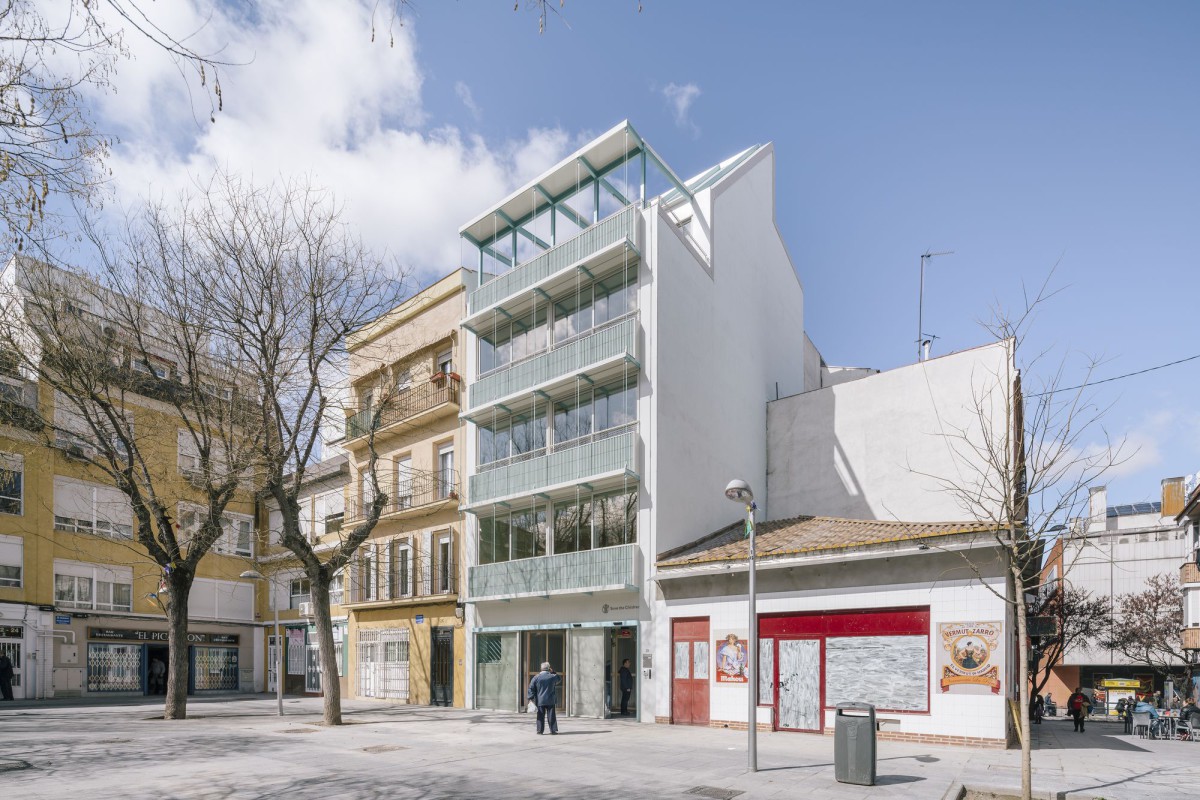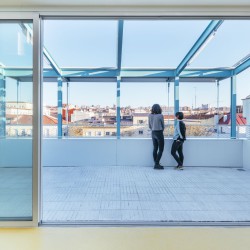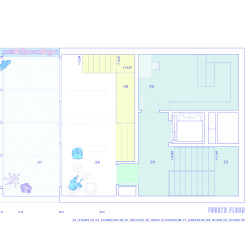elii – Uriel Fogué, Eva Gil, Carlos Palacios . photos: © ImagenSubliminal (Miguel de Guzmán + Rocío Romero)
The building for Save The Children Foundation is a strategic point in the San Diego neighbourhood for the social work that this NGO carries out in the Vallecas area. The project involves the refurbishment and extension of the current building so as to address the needs of a child care centre. The proposal is based on adding a new body that is suspended over the existing structure. This extends the building and configures a new façade, as well as a new communications and service core.The following operations are projected:
1. Refurbishment of the architectural support. A series of architectural actuations serve to update the body of this 1950s building: (a) refurbishment and consolidation of the existing structure. (b) Partial demolition of the rear of the building to integrate a new communications and service core, in compliance with current regulations guaranteeing the technical and functional performance of the main rooms. (c) Extension of the top floor, which uses up the allowed building surface with a two-level space, arranged between two terraces to favour cross-ventilation. (d) Refurbishment of the façade using a system of eaves, canopies and flower pots suspended from the top floor. This solves the problem of the (non-existent) heat insulation and the regulation of the solar radiation, while at the same time configuring the new image of the STC Foundation in the square. (e) Functional organisation to optimise the typology so that it complies with the demanding regulatory requirements for buildings to be used by children while at the same time maintaining the maximum programmatic flexibility for other potential future uses.
_
·
2. Stimulating affection. The building is equipped with certain elements to allow interaction and appropriation of the spaces by the users as well as an emotional attachment to the new headquarters. The study of some modern child care methodologies highlights the relevance of practices that encourage self-confidence, responsibility and affection for others, such as the care of pets or plants. Some of these approaches are transferred to the architectural support with a series of spatial, material, chromatic, furniture and design actuations, such as (a) Integration of mechanisms that favour a collaborative arrangement of spaces, including moving panels (in the classrooms) or portable furniture (the system of wheeled shelves in the library). They all help to structure the space in different ways and strengthen the bond between the users and the spaces. (b) Incorporation of elements that encourage care, such as plants (in the pots) and some ‘architectural pets’ (integrated within the various spaces) that will be cared for collectively. (c) Stimulation of perception by using certain materials. For instance, some of the finishes of the waiting room reflect the outside, the paving of the square flows into the hall up to the waiting room and introduces it into the building and the enclosure connects directly with the game area, breaking the barrier between the inside and the outside. (d) Incorporation of the kids’ wishes. During the bidding process, children of different ages wrote a ‘wish list’ to show how they imagined the new space. Some of their requests, such as ‘installing a chocolate fountain on each floor’ were difficult to implement in the project. Others, however, such as ‘being able to see the stars from the rooms’ have been converted into different architectural elements, such as the skylight on the roof of the screening room. In short, this set of actuations is an attempt to turn the building into a ‘pet’, to make gaming easier and to stimulate a relationship of affection towards the centre.
_
·
3. Energy strategy. A series of basic active and passive bioclimate measures have been presented to complement the comprehensive air conditioning strategy: (a) Design of a new insulated enclosure and cross ventilation whenever possible. (b) Façade system formed by canopies and eaves that reduce energy consumption for cooling in summer and heating in winter. (c) Incorporation of plants on the façade to help regulate temperature and moisture during the summer months. (d) Cold/hot conditioning system by means of underfloor heating. Thanks to all these elements, the building has the best possible energy certification, reduces its maintenance costs, while the comfort of the children, visitors and workers is ensured.
4. Phases and updates. In order to shorten the schedule and lower the required budget, the project has been presented as the essential refurbishment of a ‘basic’ hardware to allow the Foundation to start its work in the neighbourhood. Nevertheless, a number of building actuation protocols may also be incorporated so it is possible at a later date to include new elements in the ‘hardware’, adjust the performance and update the main structure as the needs of the NGO evolve. These elements include: (a) Closing of the main terrace with a greenhouse, which will be part of the active air conditioning system. (b) Possibility of incorporating solar photovoltaic energy on the roof, thanks to the optimal geometry and inclination for solar collection. (c) Implementation of new air conditioning elements. (d) Integration of new convertible furniture, etc.
These operations extract the full potential of the building by means of a programme that is both exciting and functional, as decided by the three juries (the experts, the personnel and the children) that participated in the voting.
_
Refurbishment of the building in the Plaza de Puerto Rubio for the Save The Children Foundation, Madrid
Affection Architecture
Restricted competition – 1st prize
Architects:
elii – Uriel Fogué, Eva Gil, Carlos Palacios
Team leader:
elii – Ana López
Team – Competition:
elii – Eduardo Castillo, María Rodríguez, Irene de Santos, Ana Castaño
Team – Execution project:
Eduardo Castillo, María Rodríguez, Irene de Santos, Carlos Moles, Paula Rodríguez
Surveyors:
Dirtec – Javier González y Javier Mach
Developer:
Fundación Save The Children
Structures:
Mecanismo
Mechanics:
Úrculo Ingenieros
Construction:
Diadec
Project manager:
Cushman & Wakefield – Iván Martín
Photography and video:
ImagenSubliminal – www.imagensubliminal.com
(Miguel de Guzmán + Rocío Romero)
Models:
Ana López, Lucía Fernández, Eduardo Castillo, Laura Barros, Telmo Sagartzazu
Superficie:
483,48m2
Date:
2016-2018
Location:
Vallecas, Madrid
_
·
El edificio para la Fundación Save The Children es un punto estratégico situado en el barrio de San Diego, para el trabajo social de esta ONG en el área de Vallecas. El proyecto consiste en la rehabilitación y ampliación del inmueble actual, con el objetivo de resolver el programa de un centro de atención a la infancia. La propuesta se basa en la adición de un nuevo cuerpo que se descuelga sobre la construcción existente, resolviendo la ampliación del edificio y configurando una nueva fachada, así como un nuevo núcleo de comunicaciones y servicios. Se plantean las siguientes operaciones: 1. Rehabilitación del soporte arquitectónico. Una serie de actuaciones arquitectónicas actualizan el cuerpo de este edificio construido en los años cincuenta del pasado siglo: (a) Rehabilitación y consolidación de la estructura existente. (b) Demolición parcial de la parte posterior del edificio para integrar un nuevo núcleo de comunicaciones y servicios, adaptado a las normativas vigentes que garantice las prestaciones técnicas y funcionales de las estancias principales. (c) Ampliación de la última planta, agotando la edificabilidad permitida con un espacio a doble altura, dispuesto entre dos terrazas para favorecer la ventilación cruzada. (d) Rehabilitación de la fachada, a partir de un sistema aleros, toldos y jardineras que descuelgan desde la última planta, que resuelve el (inexistente) aislamiento térmico y la regulación de la radiación solar, al tiempo que configura la nueva imagen de la Fundación STC en la plaza. (e) Organización funcional para optimizar al máximo el esquema tipológico que, dando cumplimiento a las exigentes normativas en edificios de uso infantil, preserva la máxima flexibilidad programática para otros usos posibles en el futuro. 2. Estímulo de los afectos. Se ha equipado el edificio con ciertos elementos que facilitan la interacción y la apropiación de los espacios por los usuarios, así como una relación afectiva con la nueva sede. Tras estudiar algunas metodologías contemporáneas de atención infantil, se observa la relevancia de las prácticas que incentivan la confianza, la responsabilidad y las relaciones afectivas hacia los otros, tales como el cuidado de mascotas o de plantas. Se propone trasladar algunos de estos planteamientos al soporte arquitectónico, mediante una serie de actuaciones espaciales, materiales, cromáticas, de mobiliario y de diseño, tales como: (a) Integración de mecanismos que favorecen una organización colaborativa de los espacios, como paneles móviles (en las aulas) o mobiliario portátil (como el sistema de estanterías con ruedas de la biblioteca). Unos y otros permiten estructurar el espacio de distintos modos y favorecen el compromiso de los usuarios sobre el espacio. (b) Incorporación de elementos que incentivan el cuidado, como las plantas (en las jardineras) y algunas “mascotas arquitectónicas” (integradas en los diferentes espacios) como “el gato” o “el elefante” cuyo cuidado pasará a ser una tarea colectiva. (c) Estímulo de la percepción mediante el empleo de determinados materiales. Por ejemplo, algunas de las superficies de acabado de la sala de espera reflejarán el exterior; un pavimento exterior entra desde la plaza en el vestíbulo hasta la sala de espera; el cerramiento favorece la conexión directa con la zona de juegos, rompiendo la frontera entre el interior y el exterior. (d) Incorporación de los deseos de los niños. Durante el proceso de concurso, chicos de distintas edades elaboraron una “lista de los deseos” donde expresaron cómo imaginaban el nuevo espacio. Algunas de estas peticiones como “la colocación de una fuente de chocolate en cada planta” eran difíciles de satisfacer en el proyecto. No obstante, otras, como “ver las estrellas desde las habitaciones” han sido traducidas a diferentes elementos arquitectónicos, como el lucernario que cierra la cubierta en la sala de proyecciones. En resumen, este conjunto de actuaciones “mascotizan” el edificio, facilitan el juego y tratan de estimular una relación afectiva hacia el centro. 3. Estrategia energética. Se plantean una serie de medidas bioclimáticas elementales, pasivas y activas, que se suman a la estrategia de climatización integral: (a) Diseño de una nueva envolvente aislada y ventilación cruzada cuando es posible. (b) Sistema de fachada formado por toldos y aleros que reducen el consumo de la refrigeración en verano y la calefacción en invierno. (c) Incorporación de plantas en la fachada para contribuir a la regulación de la temperatura y la humedad durante los meses estivales. (d) Sistema de climatización de frío/calor mediante suelo radiante. En conjunto, se consigue la máxima calificación en la certificación energética, así como una reducción en los gastos de mantenimiento del edificio, garantizando el confort de los niños, visitantes y trabajadores. 4. Fases y actualizaciones. Con el objetivo de acortar los plazos y ajustar el presupuesto, el proyecto se plantea como la rehabilitación elemental de un “hardware” básico que permite a la Fundación comenzar su trabajo en el barrio. Si bien, aparte, se incorporan una serie de protocolos de actuación sobre el edificio que permitirán, en el futuro, introducir nuevos elementos en el “hardware”, ajustar las prestaciones e ir actualizando el cuerpo principal según las necesidades de la ONG. Entre estos elementos cabe destacar: (a) Cierre de la terraza principal con un invernadero, que actuará como parte del sistema de climatización activo. (b) Posibilidad de incorporar energía solar fotovoltaica en la cubierta, gracias a la geometría diseñada con una orientación e inclinación óptimas para la captación solar. (c) Implementación de nuevos elementos de climatización. (d) Integración de nuevo mobiliario transformable; etc. Estas operaciones aprovechan el potencial del edificio y sacan el máximo partido del inmueble, proponiendo un programa excitante, a la vez que funcional. Así lo juzgaron los 3 jurados (el de expertos, el formado por personal de STC y el de los niños) que participaron en la votación del concurso.
_




















































